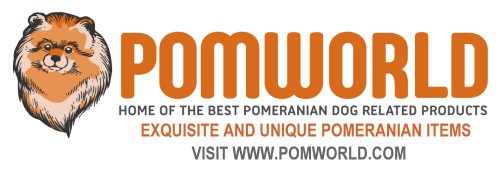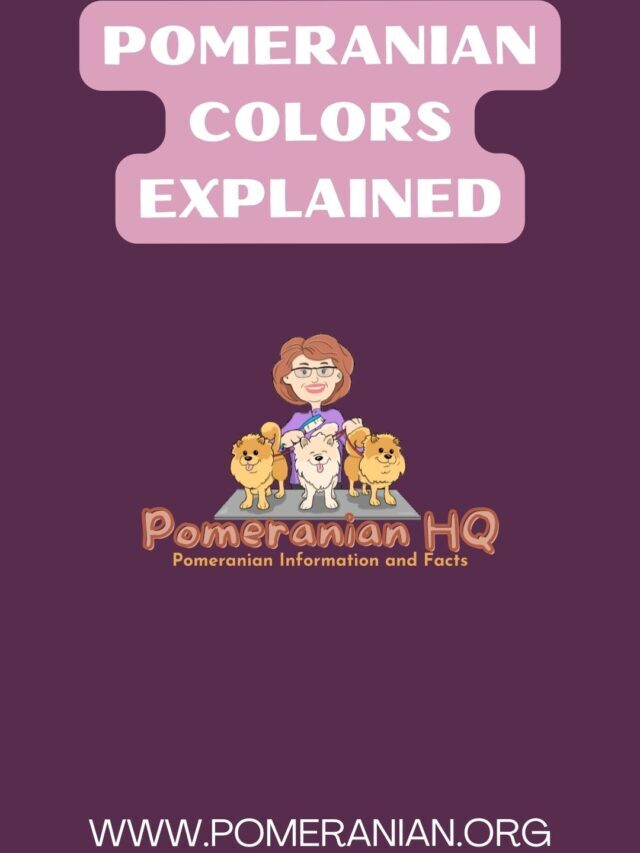Last Updated on 03/11/2023 by Dochlaggie. Post first published on May 13, 2022.
This article provides details of the rainbow of Pomeranian colors. If you have any questions about the different colors of Pomeranians, this article will answer them all.
Information includes pictures of all 25 Pomeranian puppy colors, details of all Pomeranian colors, and a Pomeranian colors chart.
Pomeranians come in various colors and patterns that would make anyone’s head spin. In this article, I take you into all the different hues a Poms can possess.
Pomeranians come in an array of colors and patterns. From solid-colored dogs like orange, red, or black to less well-known hues such as beaver and lavender.
It is important to understand the different Pomeranian colors. As an experienced breeder, I am often asked what colors do Pomeranians come in. Prospective owners will ask about toy Pom colors and what colors Pomeranians can be.
To clarify one element mentioned throughout, “Points” refers to the Pom’s rims of the eyes, lips, nose, and pads of the feet.
Every dog is unique and beautiful in its own way, but what color should you get for your new pup? Pomeranian colors range from white to black, with a variety of shades in between.
Some dogs are even born with two or three different colorings on the same body! When deciding on a puppy, it may seem easy to choose which color Pom you want, but it’s not always that simple.
The most popular colored Pomeranians are orange and orange sable because they’re warm and inviting. If you desire a more unique colored dog than these, this article describes all the rarer Pomeranian colors in detail.
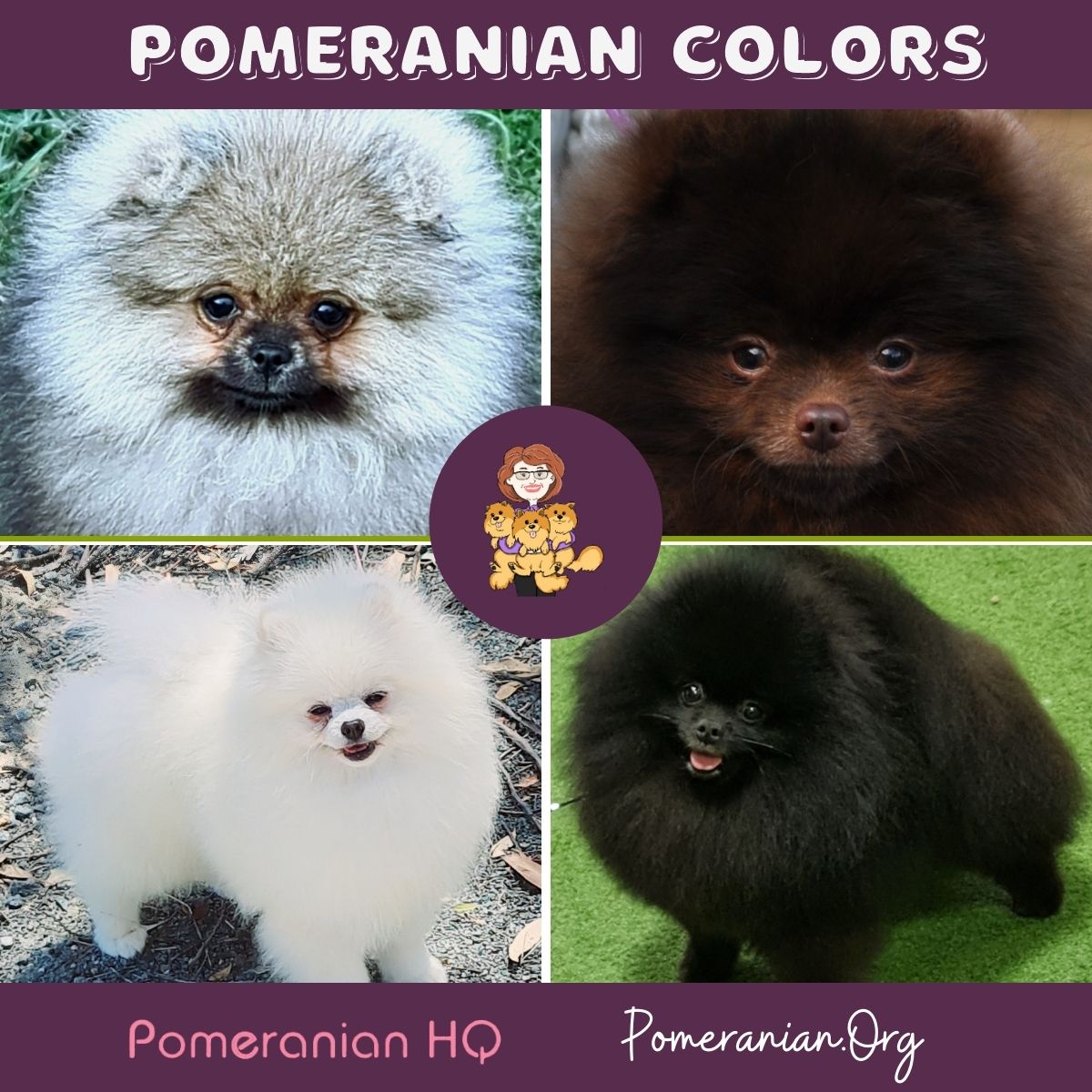
Popular Pomeranian Colors
With so many different color options to choose from, it can be hard to decide which is the best for your furry friend. I have extensively researched and compiled a list of all the colors you might see in Pomeranian dogs.
Included are the results of my recent Pomeranian coat color research.
I personally polled over 12,000 Pomeranian owners on the popularity of 25 recognized coat colors and patterns.
The results are published below in the Pomeranian color chart:
Pomeranian Color Chart: 25 Recognized Coat Colors
Color | Popularity Rank | Color & Appearance |
1 | Orange Pomeranians may vary from an intense deep rust right through to a rich gold and a light honey blonde colour. | |
2 | Cream is an extremely pale orange. | |
3 | Orange sables must have an orange body, lighter orange or even creamy undercoat with black tipping on guard hairs. | |
4 | The black and tan pattern is a base black color with tan points. | |
5 | Black Pomeranians possess a black undercoat and black guard hairs. | |
6 | A white Pomeranian should be a solid white with no lemon or cream shadings. | |
7 | Wolf Sables have a grey undercoat and the guard hair is grey with black tipping. | |
8 | The parti-color pattern is white with any other colour distributed in patches with a white blaze preferred on the head. | |
9 | Chocolate Pomeranians are a rich brown. | |
10 | ||
11 | A black base color combined with the merle pattern equals a blue merle. | |
12 | Red Pomeranians are a deep rusty color. | |
13 | The chocolate and tan pattern is a base chocolate color with tan points. | |
14 | Are a deep rusty color with sable tippings to the coat. | |
15 | Tri-color is a Parti-color Pomeranian who also displays the tan pattern as well as the parti-color pattern. | |
16 | Blue Pomeranians are diluted blacks and must have blue points. | |
17 | Blue Sables are blue base coat with dark blue guard hairs and again ending in black tipping to the guard hairs. | |
18 | The blue and tan pattern is a base blue color with tan points. | |
19 | A chocolate base color combined with the merle pattern. | |
20 | Beavers may range in colouring from a light biscuit to a darker brownish grey colour with a silvery blue cast to the coat. | |
21 | The base colour is gold, red, or orange-brindled with strong black cross stripes. | |
22 | Chocolate Sable Pomeranians have a chocolate base coat with darker chocolate guard hairs. | |
23 | The lavender Pomeranian is a greyish colour with a pinkish, chocolate hue to the coat. | |
24 | The base colour is gold, red, or orange-brindled with strong blue cross stripes. | |
25 | Either blue merle pattern with tan points or chocolate merle with tan points. |
Original Pomeranian Colors
The Pomeranians that we know today started with limited colors and were usually white, black, cream, or occasionally particolored.
Unlike their predecessors, Pomeranians are now available in various colors and patterns.
Detailed Information and Photos of Pomeranian Colors
Before we delve any further into the kaleidoscope of Pomeranians colors, let us have a quick look at the official Pomeranian colors complete list:
From the American Kennel Club Pomeranian Breed Standard:
COLOR
All colors, patterns, and variations thereof are allowed and must be judged on an equal basis.Patterns:
Brindle – Dark cross stripes on any solid color or allowed pattern.
Parti – White base with any solid color or allowed pattern. A white blaze is preferred on the head. Ticking is undesirable. Extreme Piebald: White with patches of color on head and base of tail. Piebald: White with patches of color on head, body, and base of tail. Irish: Color on the head and body with white legs, chest and collar.
Tan Points – Any solid color or allowed pattern with markings sharply defined above each eye, inside the ears, muzzle, throat, forechest, all lower legs and feet, the underside of the tail and skirt. The richer the tan the more desirable. Tan markings should be readily visible.Classifications: The Open Classes at specialty shows may be divided by color as follows: Open Red, Orange, Cream, and Sable; Open Black, Brown, and Blue; Open Any Other Color, Pattern, or Variation.
ROCS CLASS – (Red, Orange, Cream, Sable)
Sable includes: Red Sable, Orange Sable, Cream Sable, Sable, Wolf SableBBB CLASS – (Black, Brown, Blue)
AOAC CLASS
AKC designated colors and markings.
Beaver, Brindle, Merle, Parti, Tan Points, and White
Beaver Pomeranians
A Beaver Pomeranian is a dilute brown. The beaver coat can range from orange-brown to beige cream. A beaver-colored Pomeranian is a taupe color, usually with a silvery blue look to the coat tips.
In older versions of the Breed Standard, this color was called “biscuit.” One stand-out feature is the pigment on the points, which must be self-colored ( i.e. brown color).
A beaver color Pomeranian usually has hazel eyes. If a dog has black points, dark eyes, or black in his coat, he’s not a beaver or brown Pomeranian.
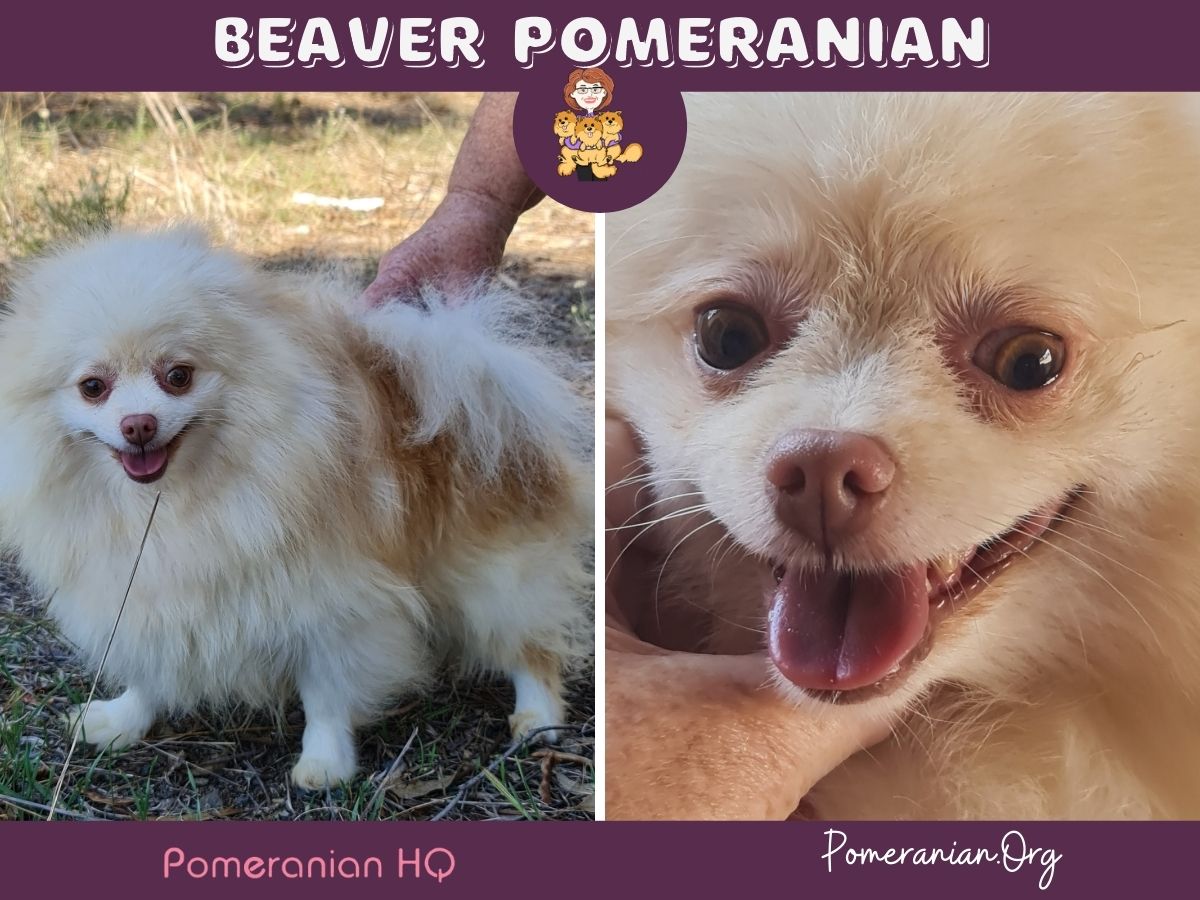
Black Pomeranian
The black Pomeranian possesses a black undercoat and black guard hair. Points must be black. Blacks should be kept out of direct sunlight to avoid a reddish tinge developing on the coat. Black Pomeranians frequently will have a few white hairs on the coat. Typically on the chest or between the pads.
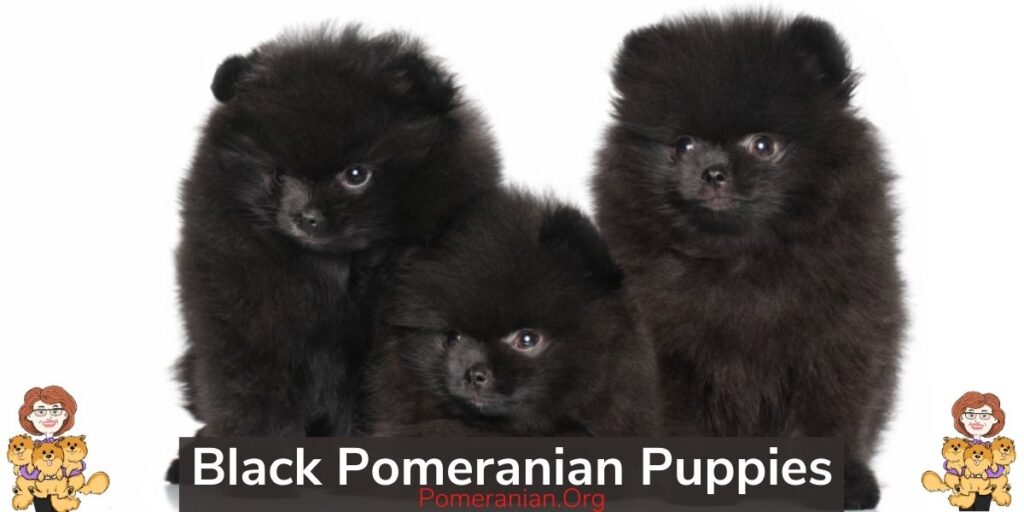
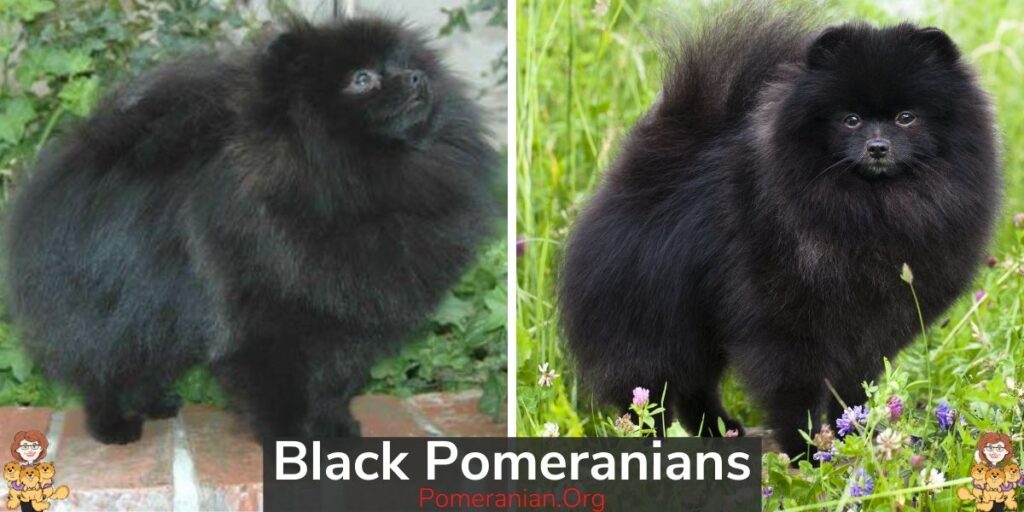
Blue Pomeranians
Blue in the Pomeranian is a solid color. A blue Pomeranian dog will have light to dark grey guard hairs and a grey undercoat with greyish-blue hair or fur.
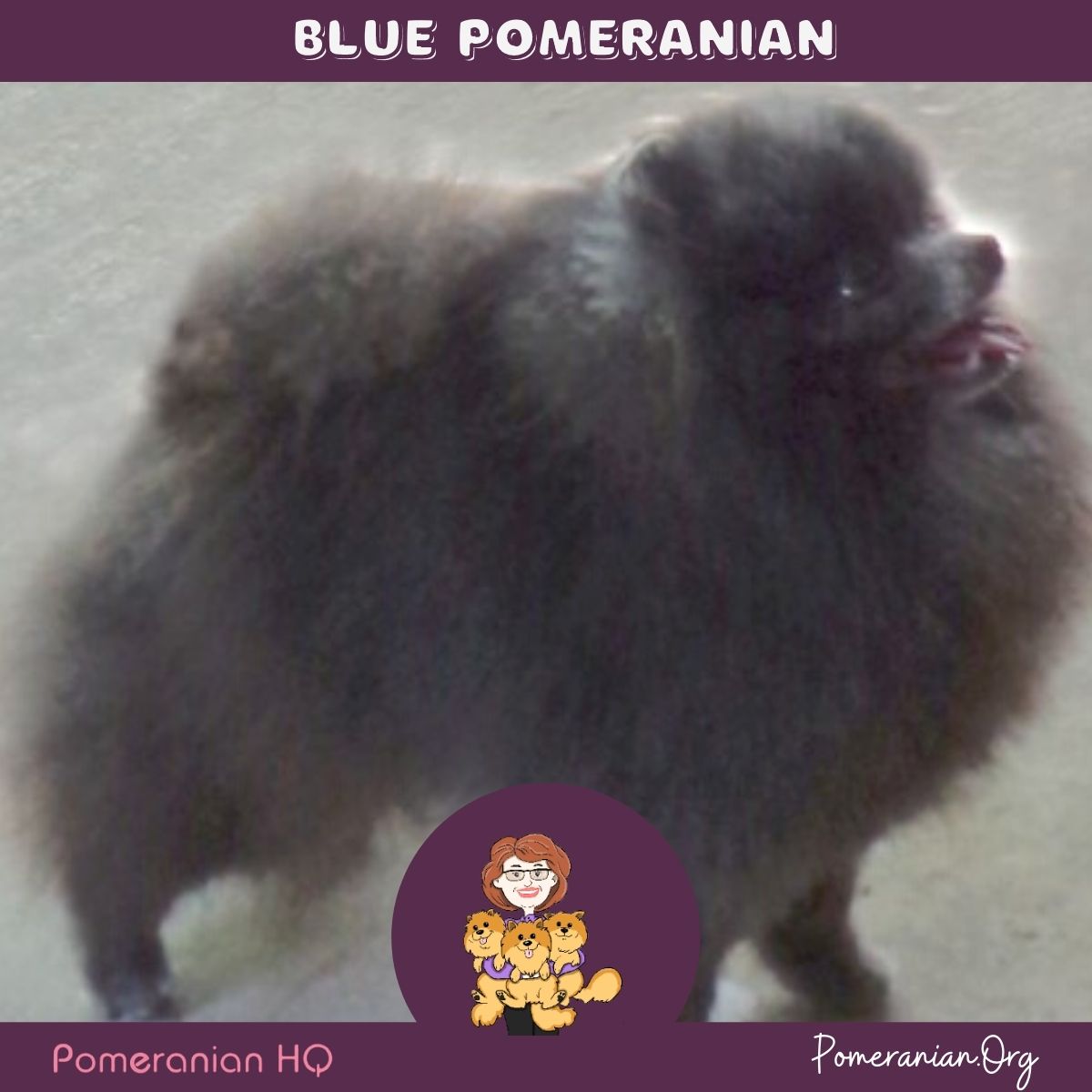
Some Blue Poms can be such a dark shade of blue that they may look black in certain light. Compare these dogs to a genuine example of the colors. At birth, Blue Pomeranian puppies are usually a silver color.
Some newborn blues may even appear to be black. Blue Pomeranian pups develop a silver/grey undercoat and a darker slate grey outer coat as they mature. Pomeranian blue is a diluted black and must have blue points (Eye rims, nose, and pads ).
Blue Poms are usually the result of breeding blacks together.
If the coat is made up of additional colors, the dog is appropriately termed a parti-color or tri-color Pomeranian.
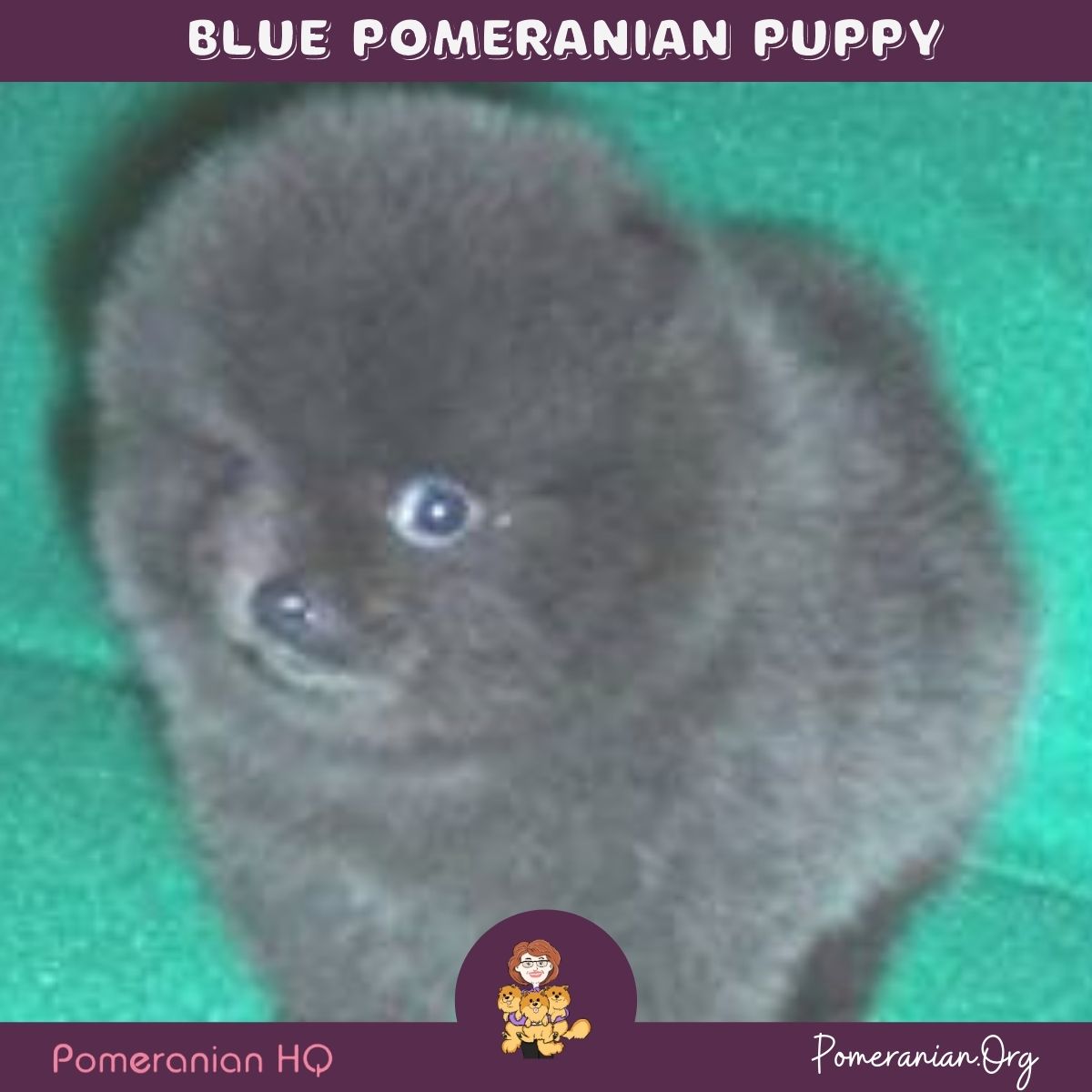
Brown Pomeranian or Chocolate Pomeranian
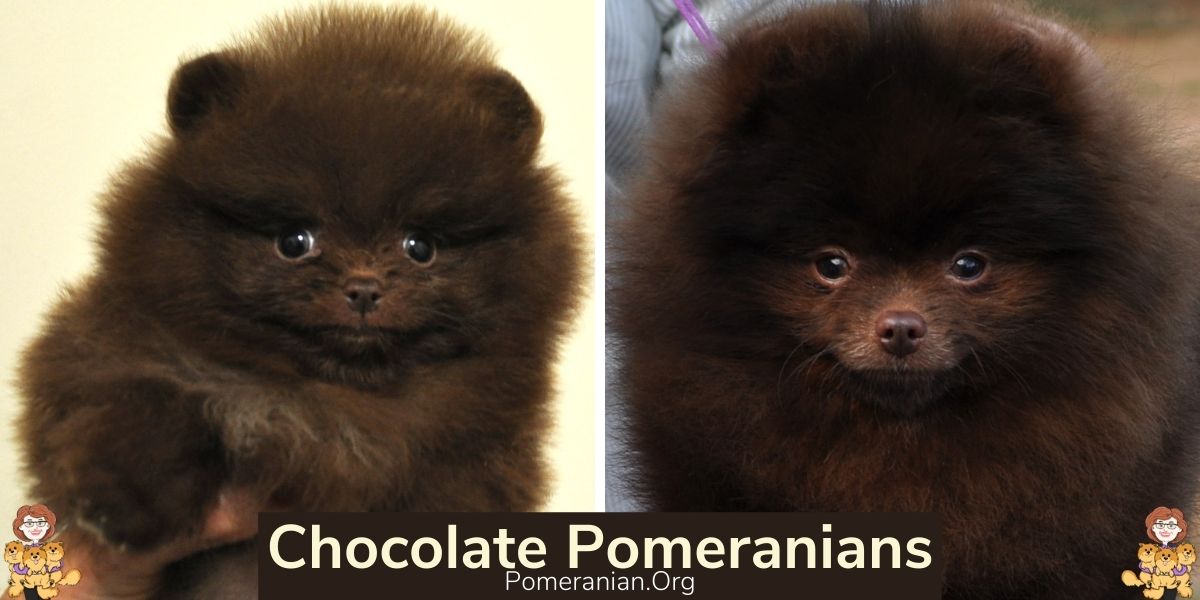
In Pomeranian dog colors, brown is a very diverse color and ranges from the light beaver shade to the darkest chocolate shade.
The chocolate Pomeranian color is rich and fully self-colored. Brown is more of a milk chocolate color and may sometimes have lighter shades.
“Sunburning” or a reddening of the color can occur if the dog spends a lot of time outside.
A Pomeranian Brown must have brown points and will, like the beaver, often have hazel eyes.
Cream Pomeranians
This Pomeranian color should be self-colored, with no white breechings. Because of the harsher texture of the guard hairs, the topcoat may appear darker.
A cream Pomeranian must possess black eye rims, nose, lips, and pads. The whiskers are usually white or straw color.
A cream-colored Pomeranian puppy is typically white at birth. When clear cream puppies are born, they appear as close to white as possible and without the ability to have any black pigmentation on their hair, and if you look closely at the whiskers, you’ll notice they have either a straw color or they’re clear.
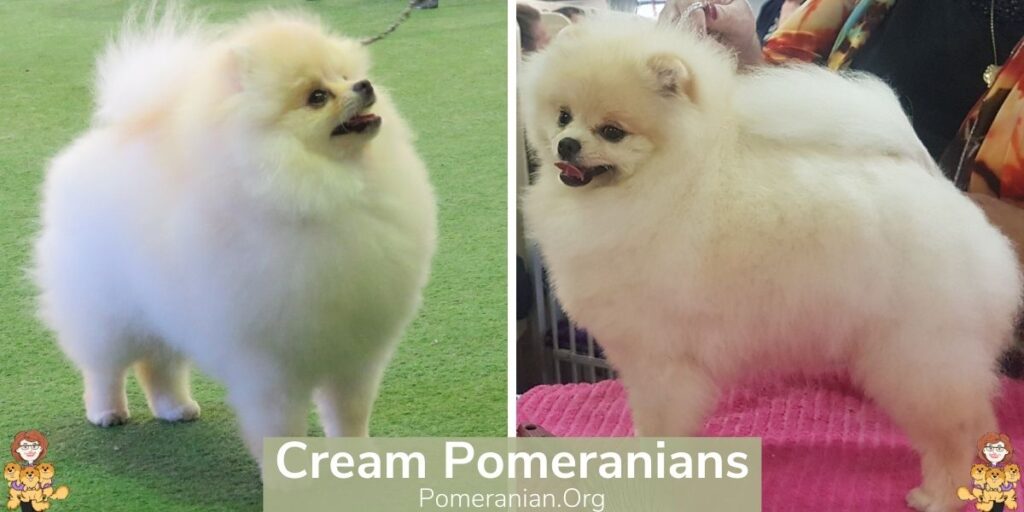
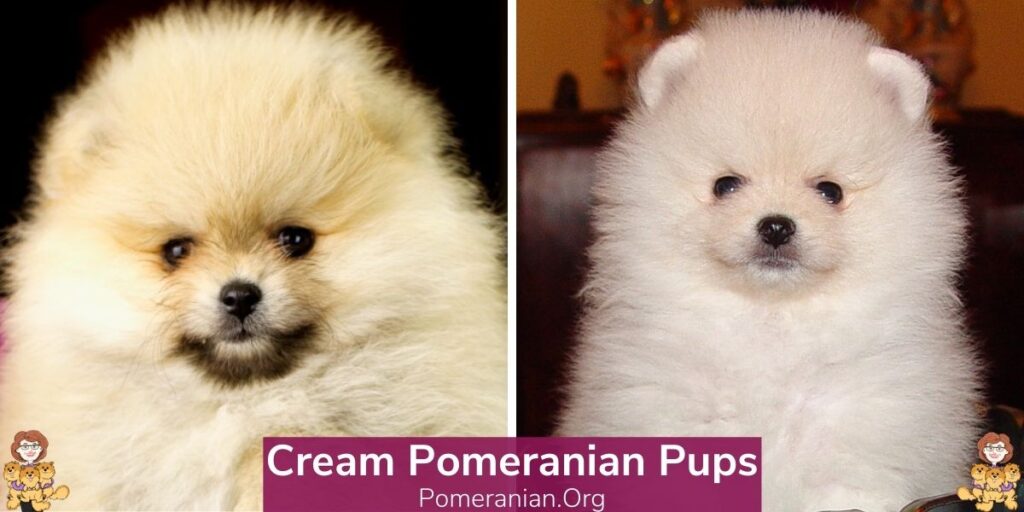
Lavender Pomeranian ( Dilute Chocolate- Isabella or Lavender)
An uncommon color is diluted chocolate. It’s possible when both blue and brown are combined on one dog (bbdd). It has a similar appearance to that of the Weimaraner because it possesses a similar mixture of genes.
It’s silvery-brown in color, often identified as Isabella or Lavender, depending on the breed. The pigment is self-colored.
The Lavender Pomeranian color is gray with a pinkish chocolate hue to the coat. The Pomeranian Lavender is regarded as a rare Pomeranian color.
If you think of a grey-colored Pom and add a small tinge of light purple, you’ll have this amazing color.
Lavender Pomeranians are often the result of breeding two dilutes, like a blue and a beaver together. Note this beautiful color is currently not AKC Pomeranian breed standard approved.
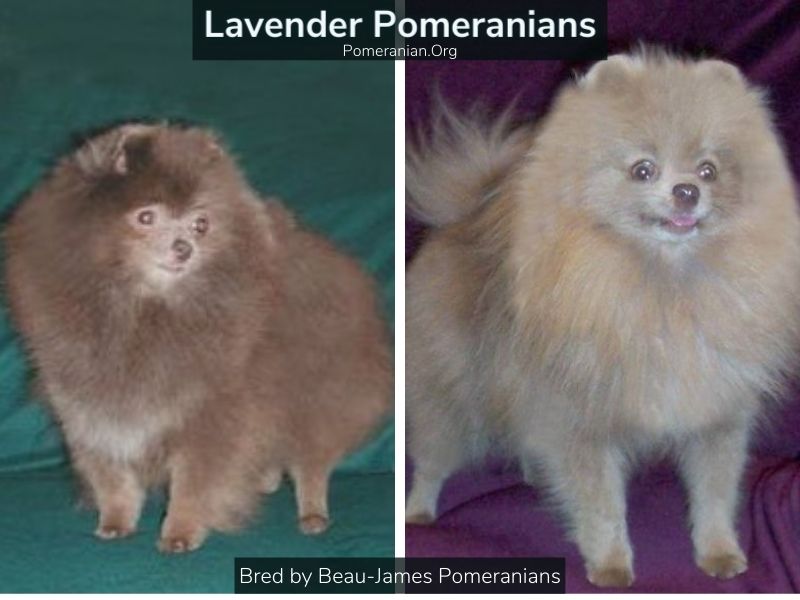
Orange Pomeranians
There is more than one type of Orange Pomeranian dog. Oranges can be born a sable color, or a light orange Pomeranian, or even appear white as a newborn. An Orange puppy can be born a darkish sable. This pup will frequently be clear to be a lovely orange Pom dog at maturity.
Another type of orange Pomeranian dog is born very pale and, sometimes, almost as white as a newborn. The coat color with this type of orange will deepen until, at maturity, this Orange Pomeranian puppy is also a beautiful orange.
Breed Standards dictate that an Orange Pom must have black points like the red pom. An adult orange pom (phenotype) can be two genetic types (genotypes). The color of new Pomeranian puppies will show the genetic difference.
When an orange Pomeranian puppy is born, he usually has sable hair, and the coat will slowly lighten and become orange in color as he ages. This type of Pomeranian puppy often turns out a bright orange color.
If the sable shadings do not fade, as an adult, this would be a Sable Orange Pomeranian. Pet Pom owners often refer to Pomeranian colors as tan being really Orange.
In some cases, he’s born with no black hair and is a clear, bright color at birth. The cause of this is the puppy being homozygous for the orange gene. (Both of the genes at the locus have the allele for the orange “ee.”) Homozygous orange poms can still range from being as dark as the red setter right through to the palest creamy-orange pom.
The points on the lighter-colored oranges may not be as dark as the poms with the sable gene. Pet owners often erroneously refer to these colored dogs as tan Pomeranians.
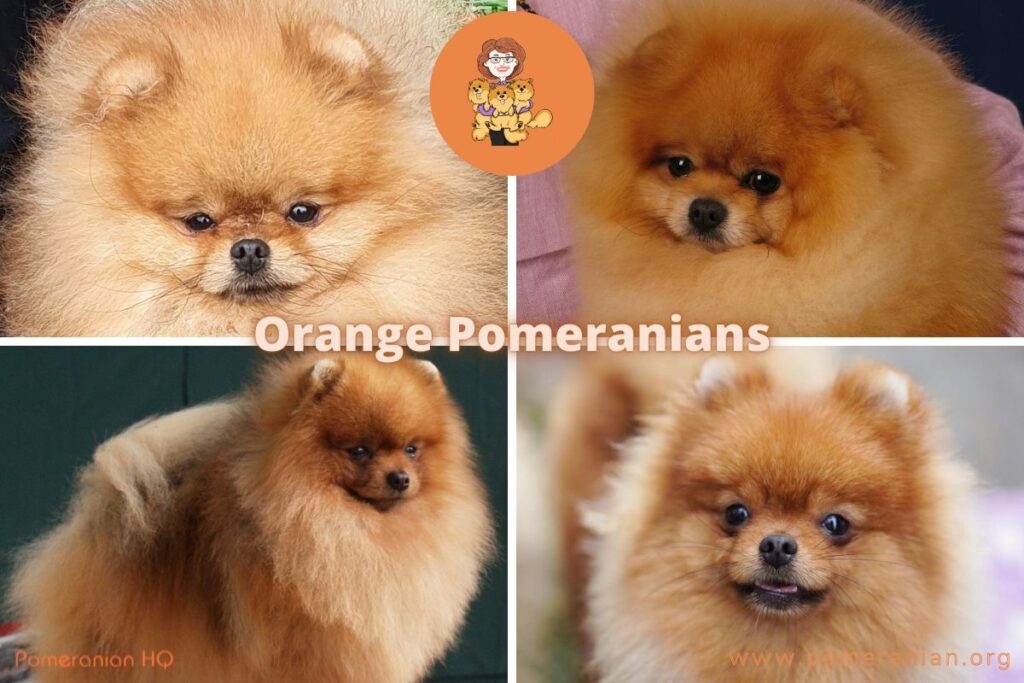
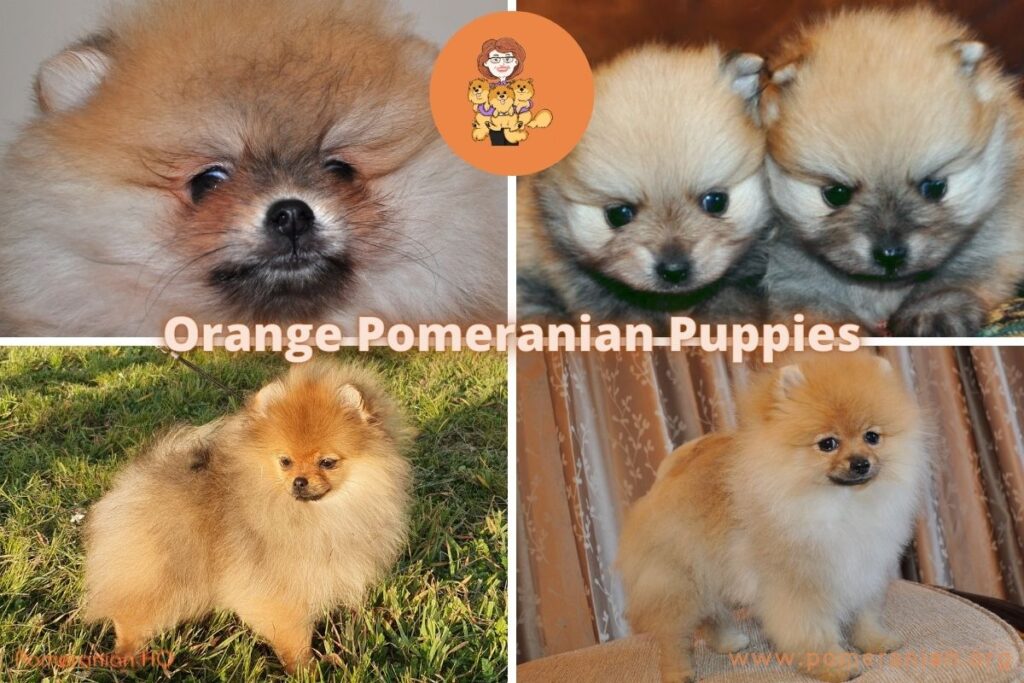
Red Pomeranians
A red Pomeranian is a deep rusty red; his points must be black.
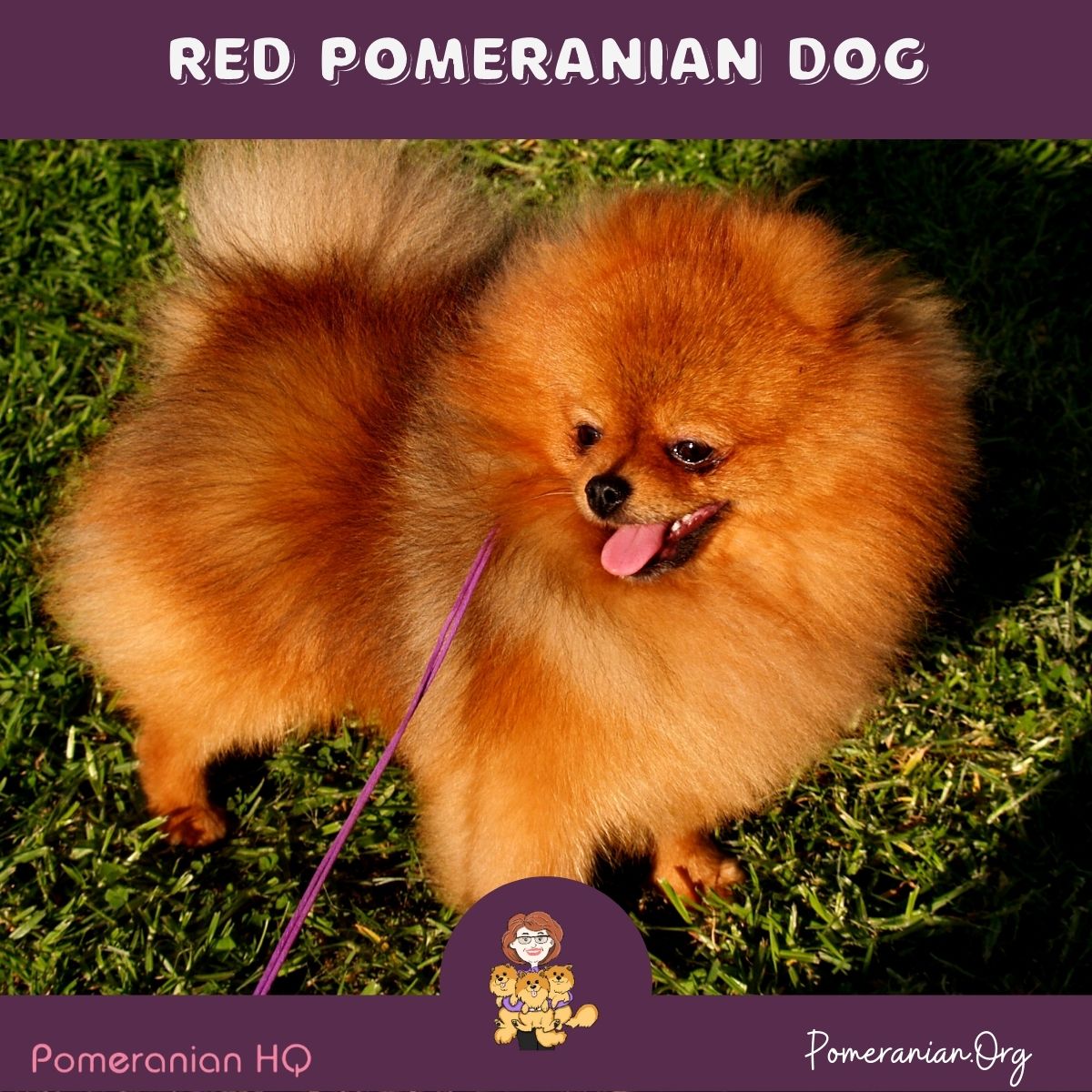
White Pomeranians
As a newborn Pom puppy, a White Pomeranian is snow white in color with pink points. As the puppy ages, the points should darken to black. An all-white Pomeranian should be a solid white color, free from any lemon or cream shadings.
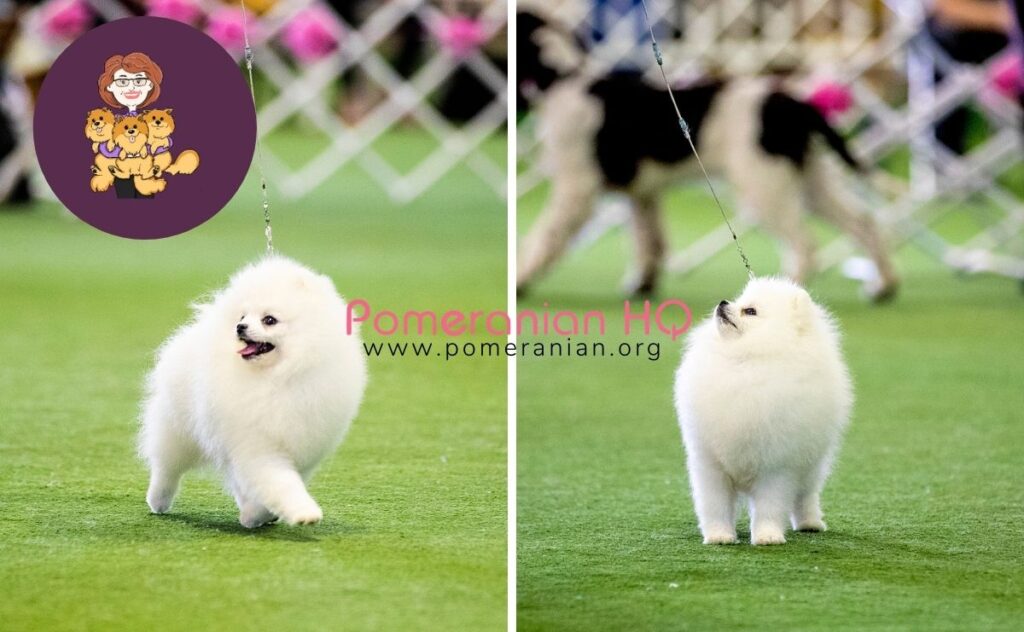
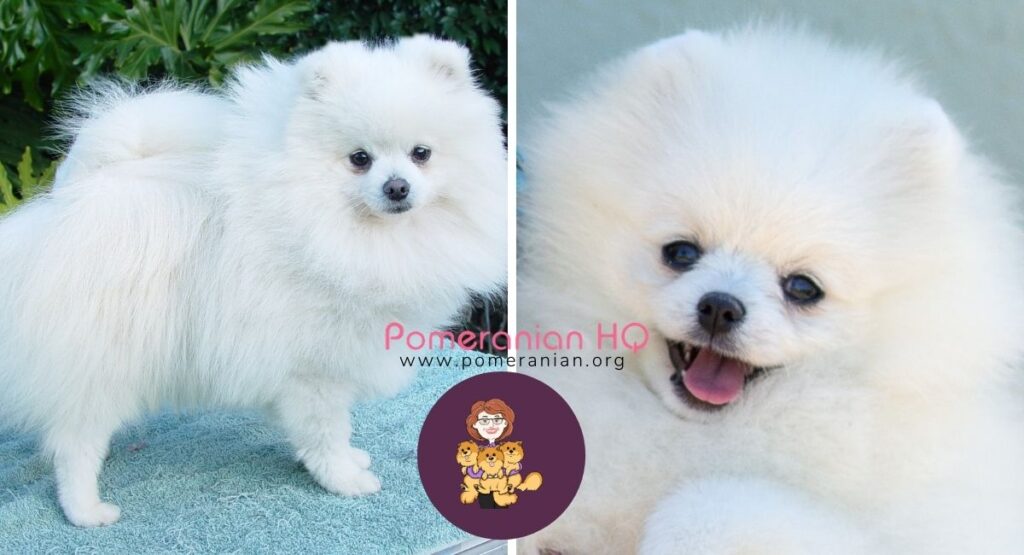
For more information and pictures of white Pomeranian adults and white Pomeranian puppies, go to our white Pomeranian dedicated page.
Pomeranian Color Patterns:
Sable Patterns
Details of sable Pomeranian colors and sable color Pomeranian photos. A Pomeranian with a sable coat has at least three colors shaded light to dark in the coat. This shading must be as consistent as possible, with no areas of self-color.
The term “Sable” refers to the darkened bands on a dog’s harsh, long guard hairs. It may be sparse, extremely dark and heavy, or somewhere in between.
The nature of the shade and pattern is another variable: whether any other recessives are present, as they may affect the strength of the black pigment.
Chocolate Sable
Chocolate sable Pomeranians have a chocolate base coat with darker chocolate guard hairs ending with tipping to the guard hairs.
A chocolate sable is the same as an orange except for the presence of two copies of a brown (b) gene (bb). This gene will convert all of the black pigment on a dog’s body to brown (including paw pads, eye rims, and nose), so everything that might have been black is brown instead.
Any orange on a body will become a warm, coppery brown. In newborn puppies, as with oranges, you can be forgiven for thinking they’re chocolate & tan until enough time passes, and you’ll see the sable bands on his forehead and body, not merely solid brown.
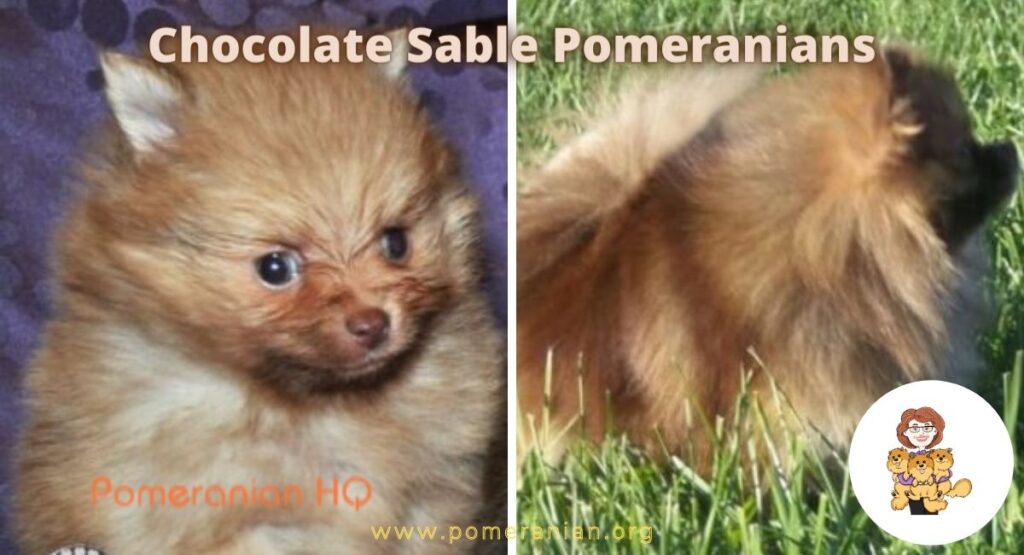
Blue Sable
Blue Sable Pomeranians are blue base coats with dark blue guard hairs and end up tipping to the guard hairs. Blue sable occurs when the dilute (d) gene decreases the depth of the existing black pigment, so it seems like it has a bluish tinge. When the puppies are born, they may seem blue.
Orange Sable Pomeranians
Have deep orange guard hairs with black tips, and the undercoat is cream or light orange in color. An orange sable Pomeranian puppy is usually very dark at birth.
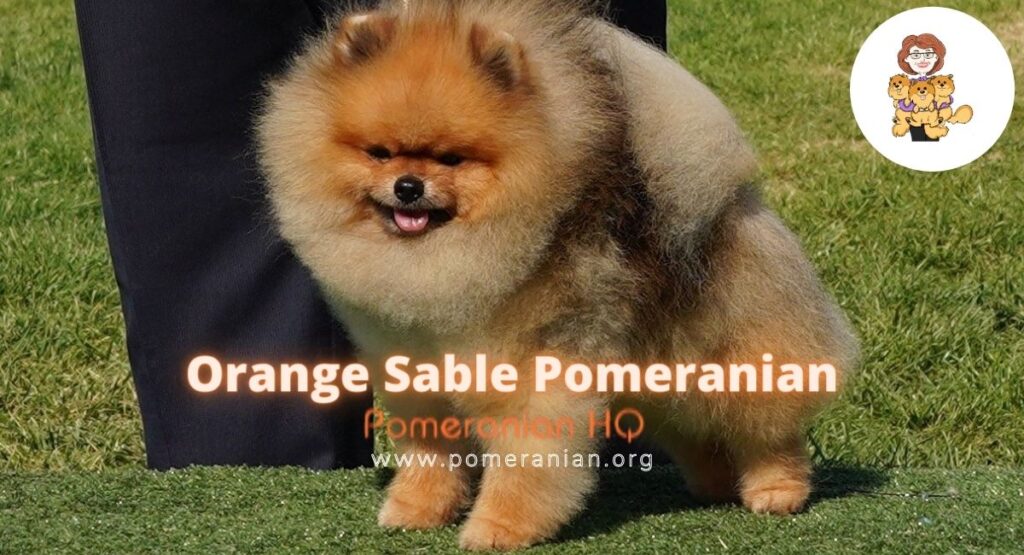
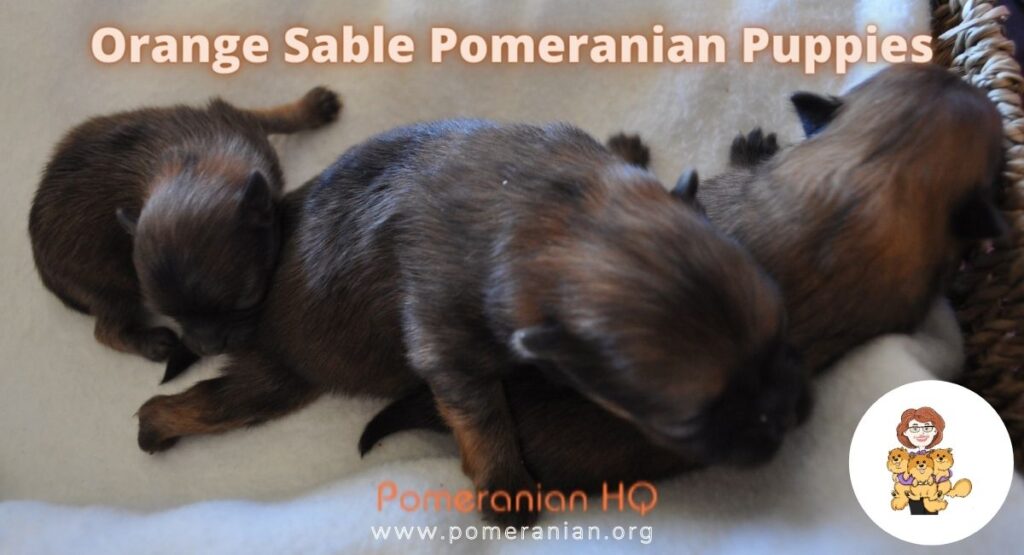
Heavy Orange Sable
Heavy sables have a lot of black guard hairs covering their body. Their appearance may resemble a black & tan except for the presence of more orange color on the head and legs than a genuine black & tan.
While they often have the black & tan and be a(y)a(t), genetically speaking, they may also have other genes present. Examples include recessive black (a), a saddle sable a(s), or a wolf sable a(w) paired with a(y) or a(s).
Wolf Sable Pomeranians
The wolf sable pattern is created by the wolf sable a(w) gene; the same one found in Keeshonds. As with Keeshonds, lighter “spectacles” should be visible around the dog’s eyes, proving they’re wolf sables, not heavy orange ones.
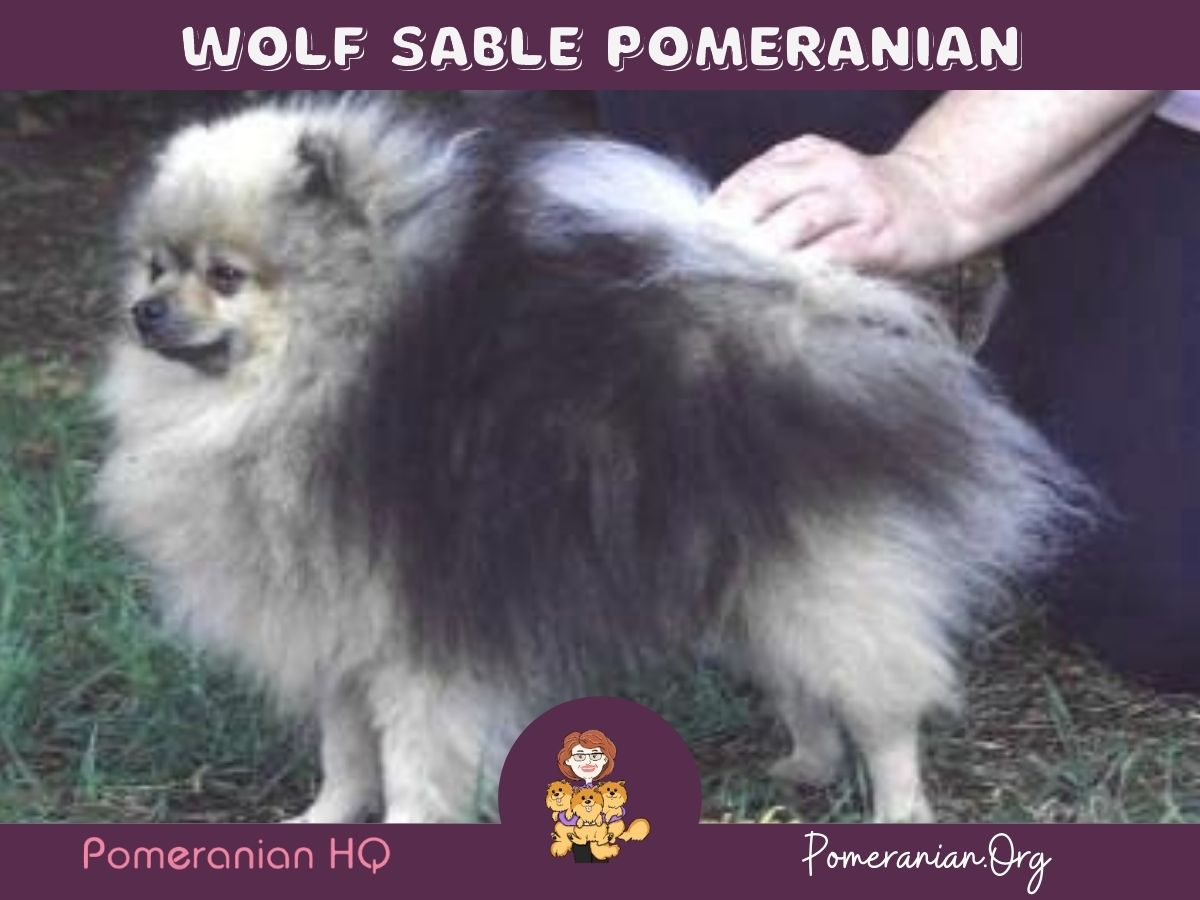
Wolf-colored Pomeranians have a grey undercoat, and the guard hair is grey with black tipping. The Pomeranian grey undercoat and guard hairs can vary in color from silvery off-white to light grey. The wolf sable Pomeranian colors are grey-shaded and must not have any hint of orange in his coat.
Beginner breeders sometimes mistakenly register a gray Pomeranian puppy as a wolf sable. Orange sable puppies often appear greyer than orange at six weeks. However, as they mature, the orange comes through.
Experienced breeders know to check behind the ears. The actual hair color behind a puppy’s ears is a reasonably accurate guide to the Pomeranian puppy’s adult coat color.
Red Sable Pomeranians
Have black tips and red hues. The red sable is nearly identical to an orange except that a reddish hue replaces the orange base. Usually, the color is that of an Irish Setter, except for black guard hairs (sables).
Cream Sable Pomeranians
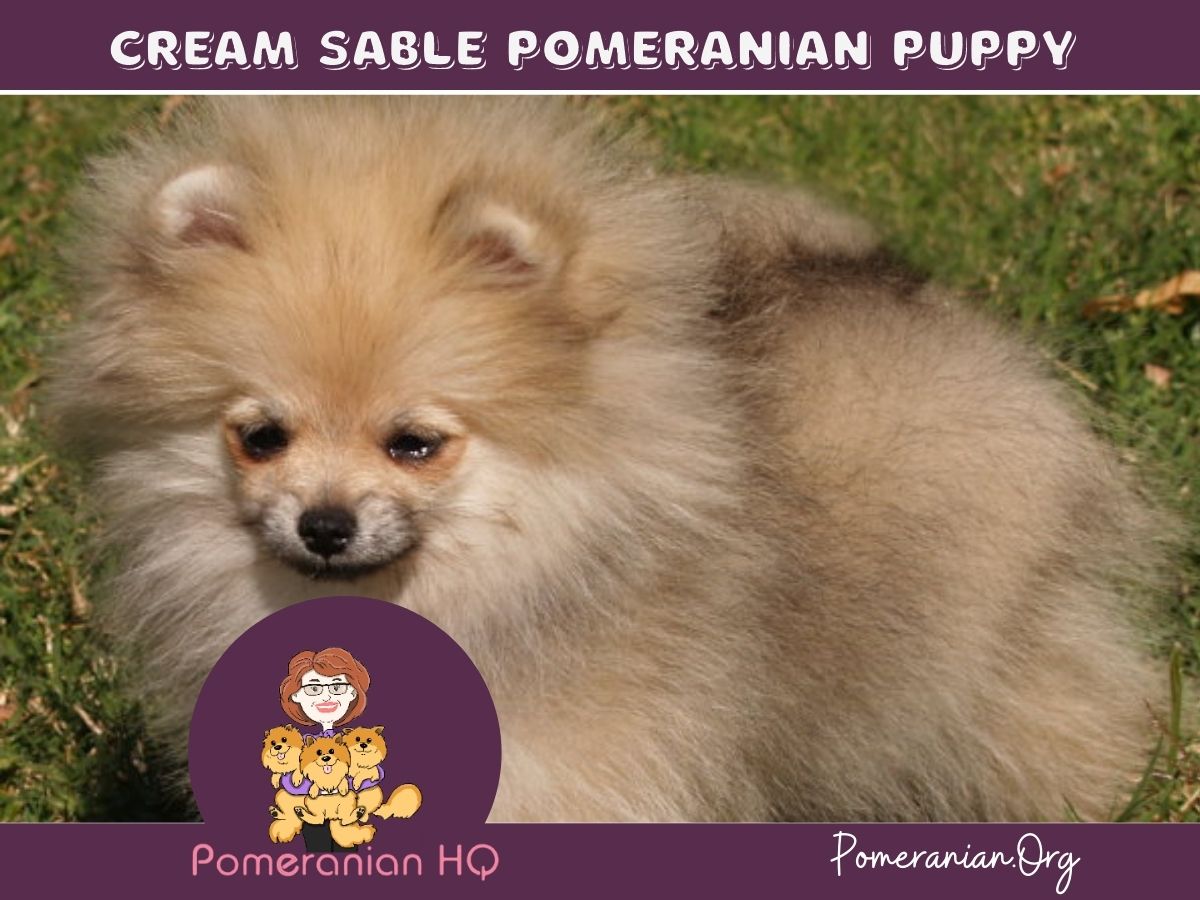
Cream sables are paler than orange sables as they have black sabling.
This color cream is usually a sooty silver as a newborn. The puppy coat is a silvery grey which is then cream with often some sable tipping to the guard hairs. A cream sable Pomeranian will have black whiskers and points. When firstborn, the puppies may have a silver color but when they become adults, it becomes a cool cream color.
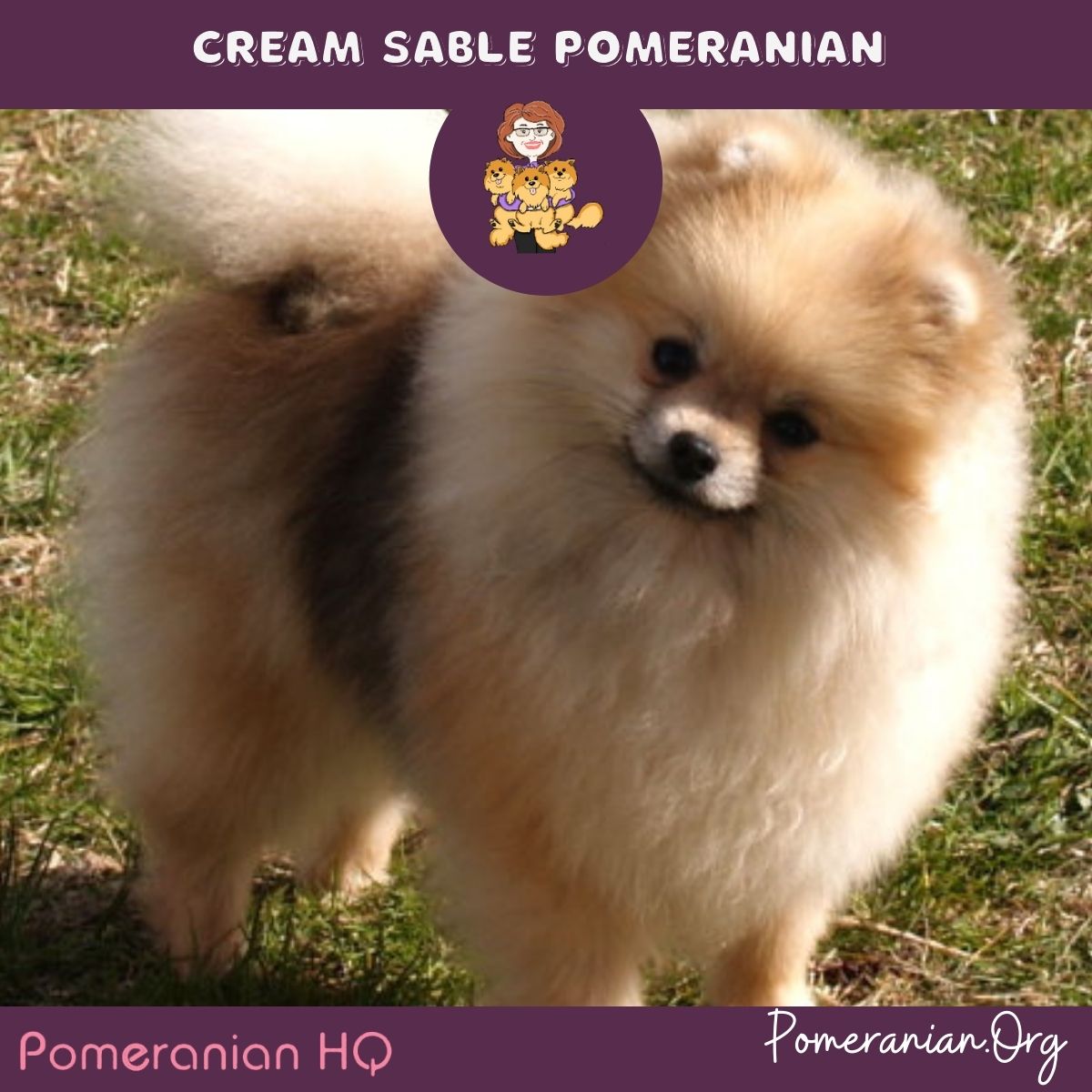
Tan Points
Pomeranians with tan points appear in three foundation colors: Blue and Tan Pomeranians, Brown and Tan Pomeranians, and Black and Tan Pomeranian.
The three colors share the same tan marking pattern. Any solid color or allowed pattern with tan or rust sharply defined, appearing above each eye and on muzzle, throat, and fore chest, on all legs and feet, and below the tail. The richer the tan, the more desirable. Tan markings should be readily visible.
Black and Tan Pomeranian
As the name suggests, these are black-colored Pomeranians with rust or tan markings. The undercoat’s base color will be lighter than the main color, and the points will be black. The rusty darker color is preferred if you have two dogs of the same quality.
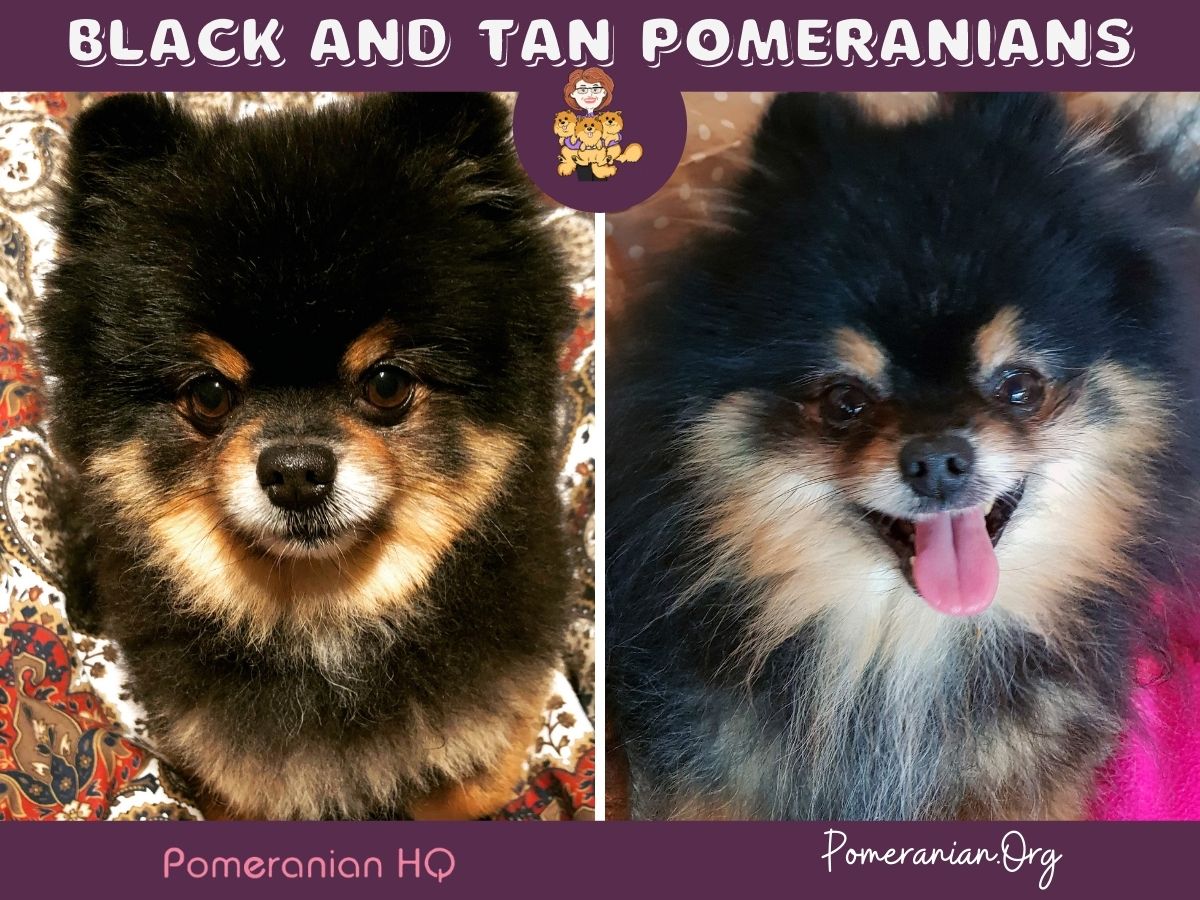
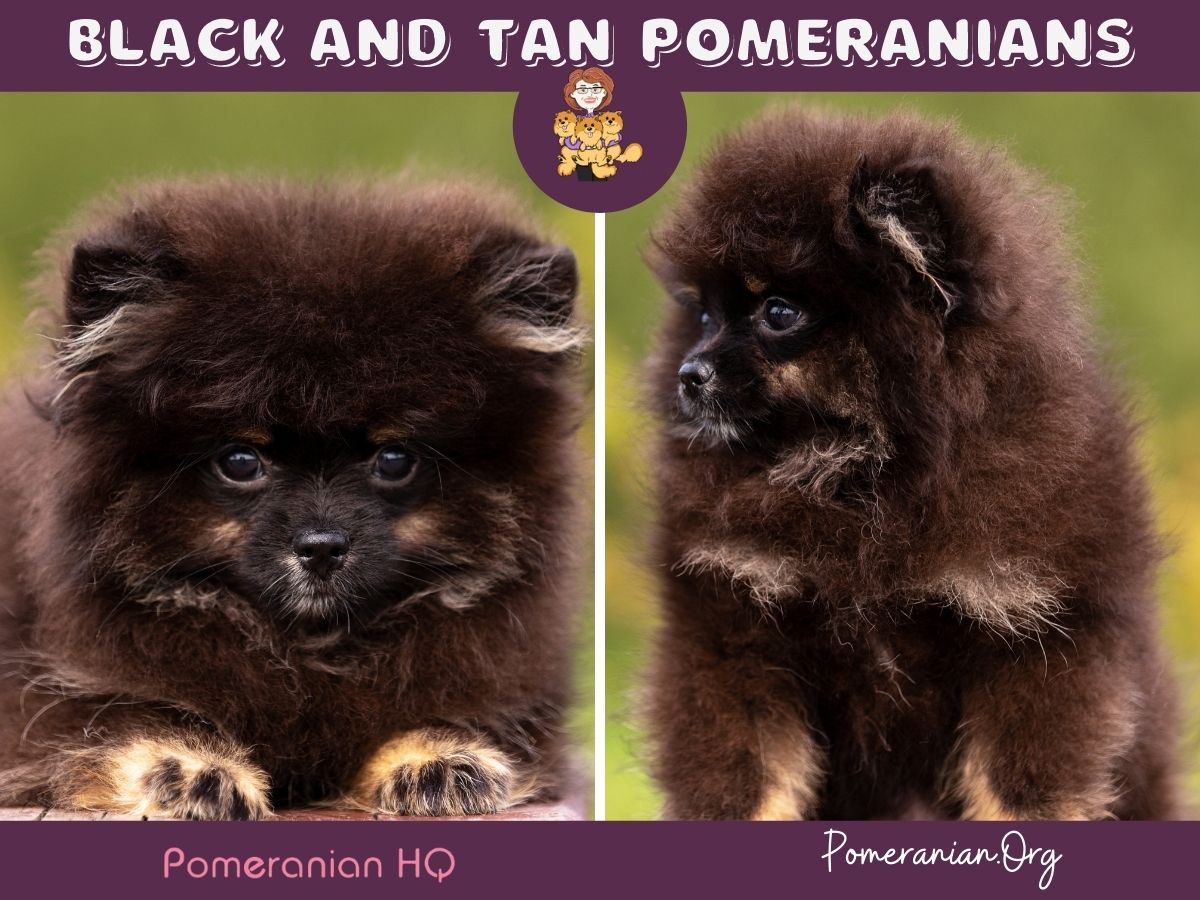
Brown & Tan Pomeranians
This is generally called Chocolate & Tan, and it covers all shades from the pale beaver with rust or tan right through to the darkest chocolate. The points will be brown, and the shade will match that of the coat.
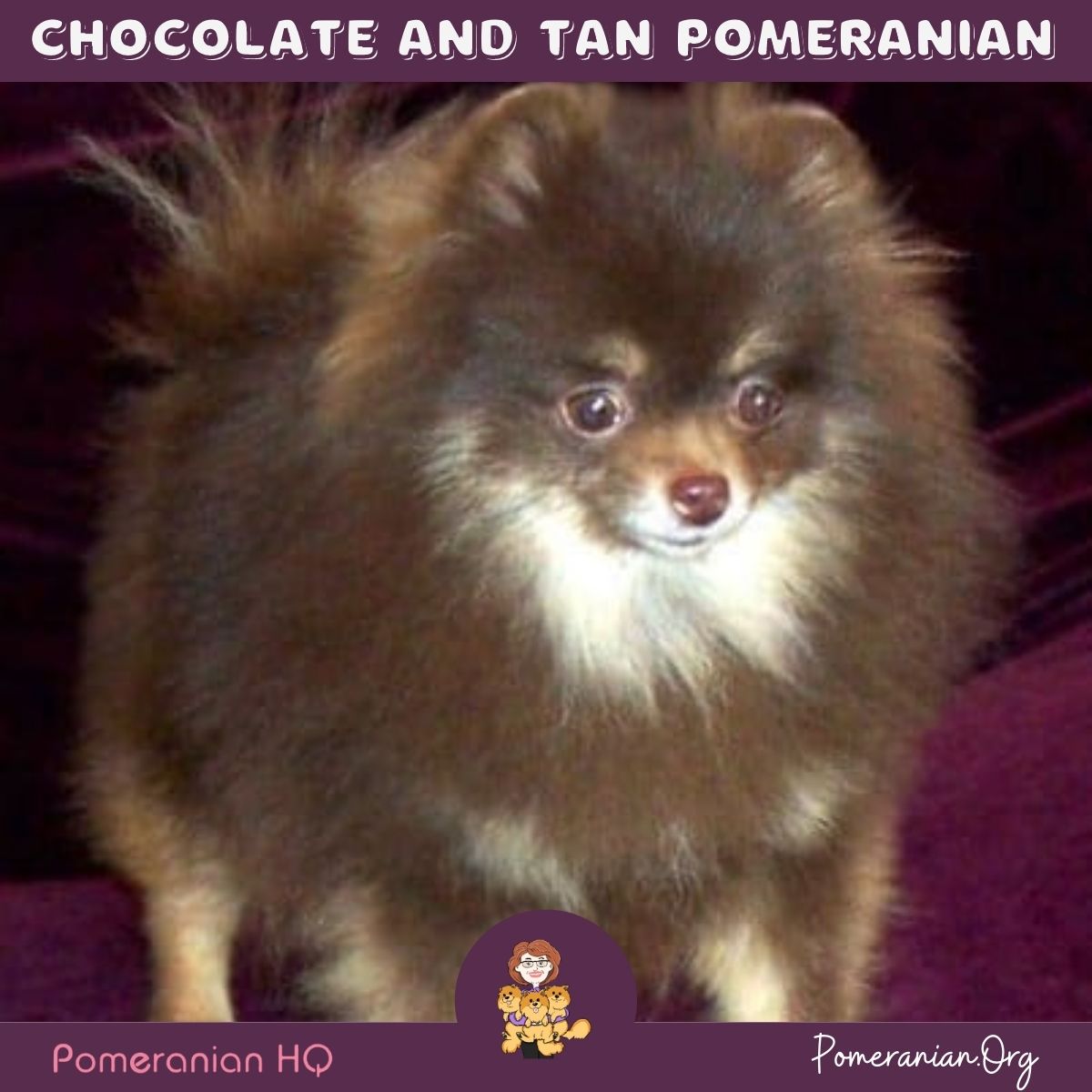
The Blue & Tan Pomeranian
These poms have rust or tan and blue color. The points will be blue and match the coat’s shade.
Brindle Pomeranians
Brindle is a pattern that has a base color and striped overlays. The base color can be: red, gold, or orange, and the brindle color is strong black stripes. It may also be combined with other patterns on a dog’s coat; for example, black and tan or parti.
The points should match the base color. Stripes may be thin or broad and may only appear on parts of the dog’s body or the entire width.
Stripes on adult brindle Pom coats may appear broken owing to the length of an adult Pom coat. Brindles often have an extremely dark dorsal stripe.
Brindle Pomeranian Genetics
A striping pattern caused by K(br), the dominant gene, is known as the Brindle. Boxers routinely have this particular look, as well as various other dog breeds. It may be masked by a solid black self-color (K) but it’s dominant over (k), being non-self-colors.
The striping can sometimes combine with other canine patterns, including parti-color, black & tan (although the stripes will only be visible on the dog’s tan sections), and merle. However, the latter generally makes it difficult to see the merle, so breeding these two together is unwise.
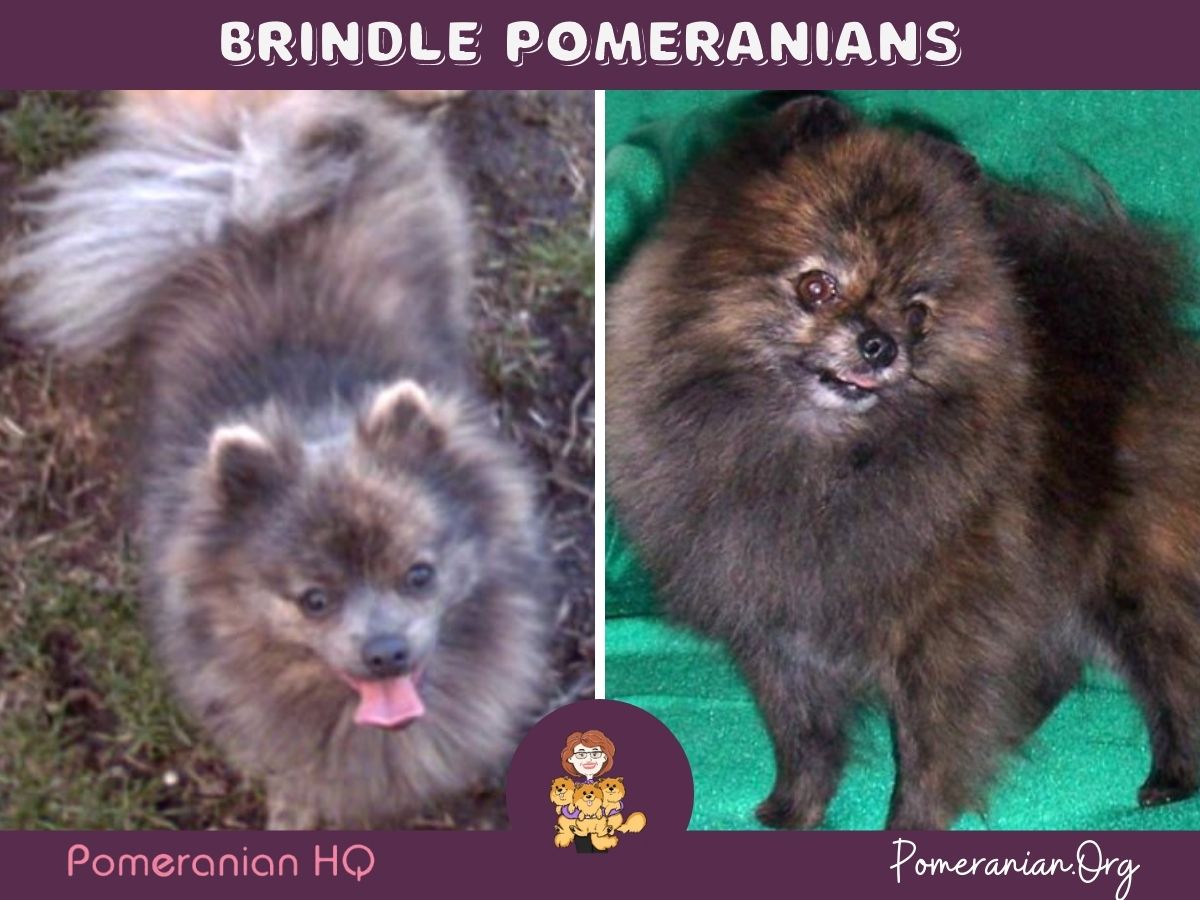
Parti Color Pomeranian
Parti-color Pomeranians are white with any other color distributed in patches with a white blaze preferred on the head. Markings on the head should be symmetrical. Excessive ticking is regarded as a fault.
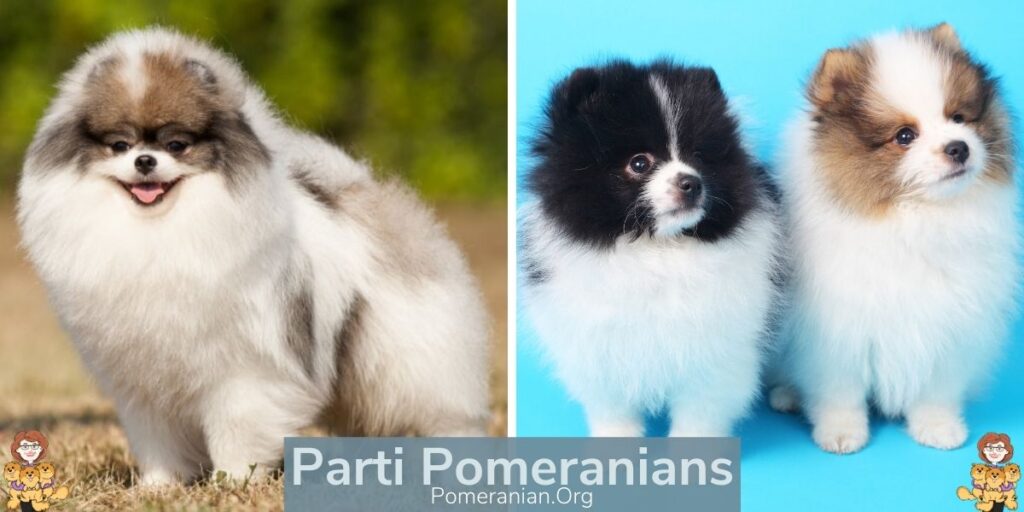
The points on particolored poms should match the color of the patches. This means black, red, cream, orange, brindle parti poms, blue and red merle, and sable colors should have black points. Blue sable and blue must have blue points. Brown merle, brown, and beaver must have brown colored points.
Parti-color is the phrase that describes dogs that have different degrees of white markings. It’s a recessive gene within the S series, where several variables occur and cause numerous patterns.
White markings may be involved in base colors or color combinations as well as other patterns.
This list will give you some idea of the diverse options:
- Black & White.
- Blue & White.
- Beaver & White.
- Brindle & White.
- Orange & White.
- Cream & White.
- Red & White.
- Lavender & White.
Then there are patterns:
- White & Sable Patterns – (wolf, cream, blue, orange, chocolate, and red sables).
- White & Tan Patterns – (blue, black, and chocolate & tan).
Parti-colored Pomeranians seem to be the most intelligent, outgoing, and active members of the Pomeranian dog world. If you have owned a parti-color Pomeranian, you will never want any other color Pom dog to share your life. I probably should have reworded that statement to read; if you have ever been owned by a parti Pom.
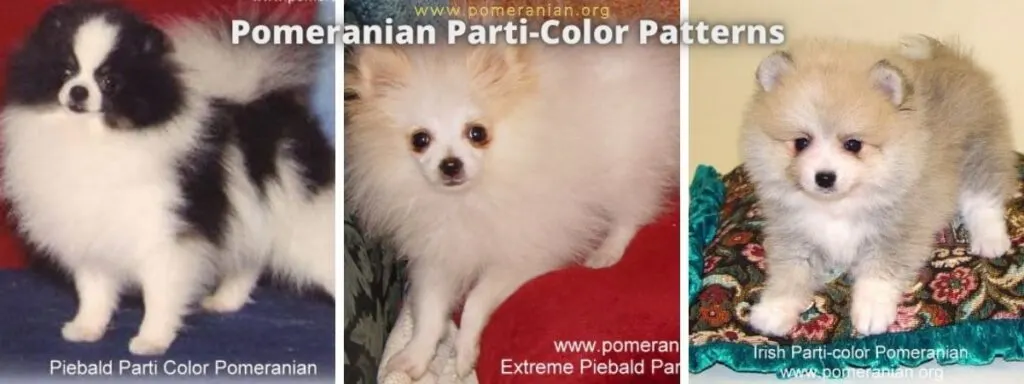
Extreme Piebald Parti Color Pomeranian
White with patches of color on the head and base of the tail.
Piebald Parti Color Pomeranian
The piebald Pomeranian is white with patches of color on the head, body, and base of the tail.
Irish Parti Color Pomeranian
This Pomeranian parti has color on the head and body with white legs, chest, and collar.
Merle Pomeranian
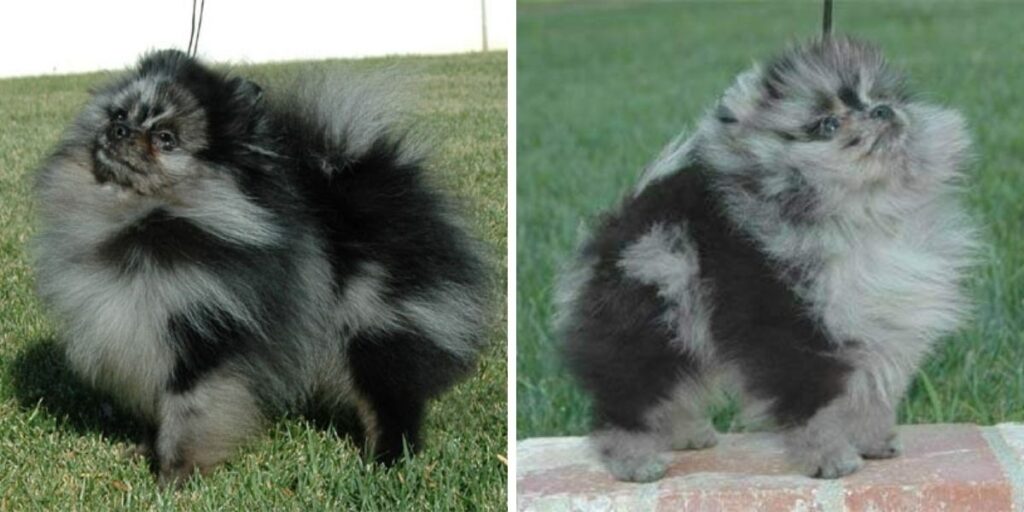
It is actually the typical gray/black pattern. The blue merle Pomeranian is in reality, a black or black and tan with the dilution gene affecting the black coat regions.
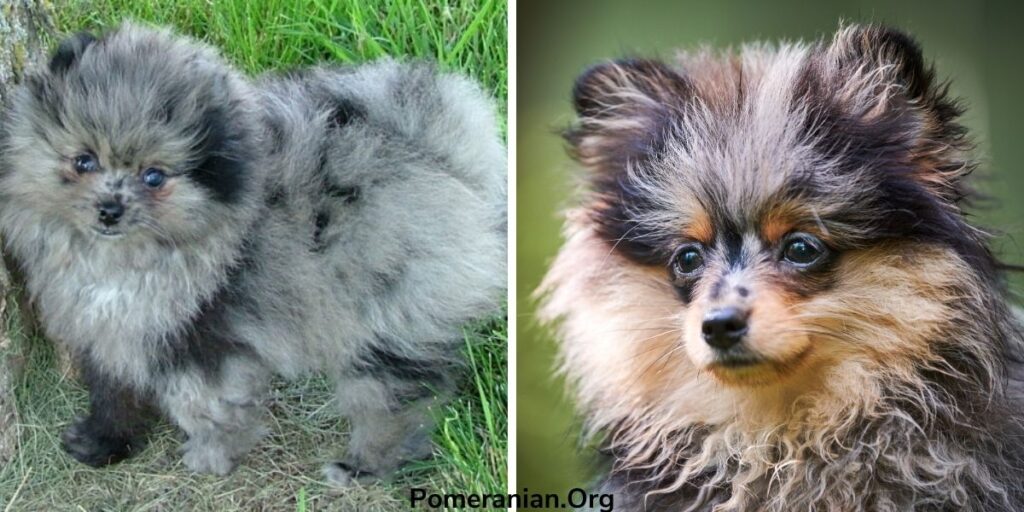
The color of the points in the merle Pomeranians is influenced by the base color e.g., Orange merles; blue merles should have black points.
Beaver, blue, and brown merle Pomeranians should have self-colored points. The Pom Breed Standard does not permit blue eyes.
Dilute Colors
Blue and Dilutes
The black pigment can be diluted to a blue color by the dilute (d) recessive gene. Any color may be affected but it’s when solid black is chosen that the results are most distinct, transforming it into a variety of blue shades.
Chocolate is another pigment that changes quite remarkably into a lavender/isabella.
Other Dilute Colors
The diluted recessive gene can affect any dog with a black pigment. So, you may notice different varieties, such as a diluted sable with blue pigment and hair instead of the usual black.
The other variety may be blue & tan, which is similar to black & tan except that blue replaces black. His footpad, nose, and eye pigment also follow the blue color.
Any Other Allowable Color
& Tan Parti-Color. A color that is named an “& tan” has the “& tan” pattern and also the particolored pattern (i.e., a tan-pointed parti). E.g. a Tri Colored Black & Tan parti color Pomeranian. Again the color of the points should match the color of the particolored coat patches.
Pomeranian Color Classifications:
The Open Classes at specialty shows may be divided by color as follows: Open Red, Orange, Cream, and Sable; Open Black, Brown, and Blue; Open Any Other Color, Pattern, or Variation.
ROCS CLASS: (Red, Orange, Cream, Sable)
N.B. Sable includes Red Sable, Orange Sable, Cream Sable, Sable, and Wolf Sable.
BBB CLASS: (Black, Brown, Blue)
AOAC CLASS: Beaver, Brindle, Merle, Parti, Tan Points, and White.
Pomeranian Color Chart

Pomeranian Markings
Pomeranian markings recognized by the AKC:
- Black Muzzle
- Brindle – the base color is gold, red, or orange-brindled with strong black cross stripes
- Parti-color – is white with any other color distributed in patches with a white blaze preferred on the head.
- Black Mask
- White Markings
The AKC ( American Kennel Club ) Pomeranian Breed Standard ( approved July 12th, 2011:
“ All colors, patterns and variations thereof are allowed and must be judged on an equal basis.”
The U.K. Pomeranian Breed Standard ( updated April 2017 :
“All WHOLE colours permissible. In mixed classes where whole coloured and parti coloured Pomeranians compete together, the preference should, if in all other points they are equal, be given to the whole coloured specimens. Merles not permissible.”
Pomeranian Nose Color
Pomeranians can have black noses or be self-colored depending on their coat color.
Nose – Pigment is black except self-colored in chocolate, beaver and blue.
From the AKC Pomeranian Breed Standard.
Pomeranian Eye Color
Eyes – dark, bright, medium sized, and almond shaped; set well into the skull with the width between the eyes balancing the other facial features. Eye rims are black, except self-colored in chocolate, beaver and blue.
From the AKC Pomeranian Breed Standard.
Sometimes Pomeranians come in all sorts of colors. Some may have dark eyes, but other eye colors possible in Pomeranians are the hazel eyes of chocolate and beaver Pomeranians.
The color of a dog’s eyes can be determined by its genetic makeup. Some dogs have merle genetics, and these animals often possess blue eyes.
Two different colored eyes can be seen in dogs with merle genetics.
Disqualifications: Eye(s) light blue, blue marbled, blue flecked.
From the AKC Pomeranian Breed Standard.
Pomeranian Colors Explained Web Story
Pomeranian Colors Conclusion
Pomeranians will always have a special place in my heart regardless of their coat color. They capture their owner’s hearts with their unique personality and adorable demeanor.
I hope you’ve enjoyed this article and found it informative. If you have any questions. I encourage you to drop me a line in the comments or by email. I am always happy to answer any Pomeranian-related questions.
Copyright Pomeranian.org. All Rights Reserved.
List of colors of Pomeranians needed: Pictures of Pomeranian fur colors are required for this Pomeranian website. Many different Pomeranian colors are still needed to complete this article. If you are able to provide any of the rare colored Pomeranian pictures, please contact us via the site contact form.
Pom colors required are examples of blue & tans, lilac Pomeranian, chocolate and tans, blues, blue sables, another adult merle, red sables, parti Pomeranian, Irish parti-color, and some of the rare Pomeranian colors are required. Dogs and owners will be acknowledged as required.
A big thank you to all those who have helped with this education project on Pomeranian coat colors.
References and Further Reading:
[1] Official Standard of the Pomeranian (AKC). American Kennel Club, 2011.
[2] English Kennel Club Pomeranian Breed Standard, 2017.
[3] Denise Leo, The Pomeranian Handbook.
[4] Milo G. Denlinger “The Complete Pomeranian”.
[5] Kimbering Pomeranians “1891-1991”.
[6] William Taplin “The Sportsman’s Cabinet”.
[7] E. Parker “The Popular Pomeranian”.
[8] Lilla Ives “Show Pomeranians”.


